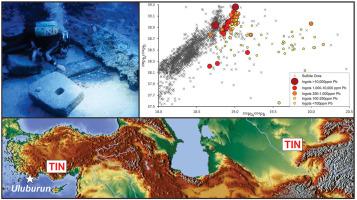Journal of Archaeological Science ( IF 2.6 ) Pub Date : 2021-08-14 , DOI: 10.1016/j.jas.2021.105455 Wayne Powell 1 , Michael Johnson 2 , Cemal Pulak 3 , K. Aslihan Yener 4 , Ryan Mathur 5 , H. Arthur Bankoff 6 , Linda Godfrey 7 , Michael Price 8 , Ehud Galili 9

|
Lead isotope analysis (LIA) can be applied to tin provenance studies when both the U–Th–Pb characteristics of cassiterite and potential Pb contamination are taken into account. As cassiterite (SnO2) contains higher concentrations of U than Pb and negligible Th, radioactive decay increases 206Pb/204Pb and 207Pb/204Pb ratios in cassiterite over time. However, 208Pb/204Pb ratio retains its primary value and can be correlated with LIA databases. A majority of documented Bronze Age tin ingots from Europe have Pb in excess of the 5 ppm maximum that can be derived from Cenozoic to Late Paleozoic cassiterite. A minute mass of galena (PbS) in the ore concentrate is sufficient to mask the cassiterite-derived lead, as would the addition of any lead contaminant introduced in the smelting/casting process. If the galena is cogenetic with the cassiterite, then LIA will be unaffected. The inclusion of uranium-rich minerals in the tin ore concentrate is another potential source of excess lead. In this case, the additional Pb is uranogenic, and so 206Pb/204Pb and 207Pb/204Pb will reflect the age of the uranium minerals, but 208Pb/204Pb will retain its primary value. If the U-minerals are cogenetic or coeval with tin mineralization, then a Pb isochron age will indicate the age of the ore.
Between 1984 and 1994, at least 117 ingots, or roughly one tonne, of tin was raised from the Late Bronze Age Uluburun shipwreck (ca. 1320 B.C.). Over half of the analyzed ingots from this wreck site have high Pb concentrations (>100 ppm), indicative of contamination from non-radiogenic lead associated with lead metal or galena. LIA indicates that the Pb originated from the Pb–Ag-rich Bolkardağ region of the south-central Taurus Mountains. A second group of approximately 28 tin ingots with lower Pb content (<100 ppm) contain additional uranogenic Pb but retain 208Pb/204Pb compositions that overlap with the ca. 300 Ma tin regions of Western Europe and Central Asia, with the most likely source being the Tienshan Mountains in Kyrgyzstan, Tajikistan, and Uzbekistan.
By compensating for previous uncertainty around the use of Pb isotopes for sourcing tin objects, it is now possible to contextualize the Uluburun tin ingots more securely within the metallurgical systems of the Central Taurus-Cilicia-Amanus axis. Recent scholarship has shown that tin production in the South-Central Taurus region had taken place at a scale not previously anticipated. Two parallel production systems appear to have been in place serving elite and common consumption networks via markedly different technologies. The South-Central Taurus and Cilician cities served as important components of maritime and terrestrial metal distribution around the eastern Mediterranean, providing a range of metals from a single geographical region.
中文翻译:

从峰到港口:从乌鲁布伦锡锭铅同位素分析的适应性应用中洞察锡的来源、生产和分布
当同时考虑锡石的 U-Th-Pb 特征和潜在的 Pb 污染时,铅同位素分析 (LIA) 可用于锡来源研究。由于锡石 (SnO 2 ) 的 U 浓度高于 Pb,而 Th 可忽略不计,因此随着时间的推移,锡石中的放射性衰变会增加206 Pb/ 204 Pb 和207 Pb/ 204 Pb 的比率。然而,208 Pb/ 204Pb 比率保留其主要值并且可以与 LIA 数据库相关联。大多数记录在案的来自欧洲的青铜时代锡锭的铅含量超过 5 ppm 的最大值,这可以从新生代到晚古生代锡石中提取。精矿中的少量方铅矿 (PbS) 足以掩盖锡石衍生的铅,就像在熔炼/铸造过程中添加的任何铅污染物一样。如果方铅矿与锡石是共同遗传的,那么 LIA 将不受影响。锡精矿中含有富铀矿物是过量铅的另一个潜在来源。在这种情况下,额外的 Pb 是产铀的,因此206 Pb/ 204 Pb 和207 Pb/ 204Pb 将反映铀矿物的年龄,但208 Pb/ 204 Pb 将保留其主要价值。如果 U 矿物与锡矿化是共生的或同时期的,则 Pb 等时线年龄将指示矿石的年龄。
1984 年至 1994 年间,从青铜时代晚期的乌鲁布伦沉船(约公元前 1320 年)中捞出了至少 117 块锡锭,大约一吨。来自该沉船地点的超过一半的分析锭具有高 Pb 浓度 (>100 ppm),表明与铅金属或方铅矿相关的非放射性铅污染。LIA 表明 Pb 起源于 Taurus 山脉中南部富含 Pb-Ag 的 Bolkardağ 地区。第二组大约 28 块铅含量较低 (<100 ppm) 的锡锭含有额外的产铀铅,但保留了208 Pb/ 204 Pb 成分,与大约 西欧和中亚的300个马田地区,最可能的来源是吉尔吉斯斯坦、塔吉克斯坦和乌兹别克斯坦的天山山脉。
通过补偿之前使用铅同位素采购锡制品的不确定性,现在可以在金牛座-西里西亚-阿曼努斯轴的冶金系统中更安全地将乌鲁布伦锡锭置于背景中。最近的研究表明,金牛座中南部地区的锡生产规模达到了之前未曾预料到的程度。两个平行的生产系统似乎已经通过明显不同的技术服务于精英和普通消费网络。中南部的金牛座和西里西亚城市是地中海东部海洋和陆地金属分布的重要组成部分,提供来自单一地理区域的一系列金属。











































 京公网安备 11010802027423号
京公网安备 11010802027423号